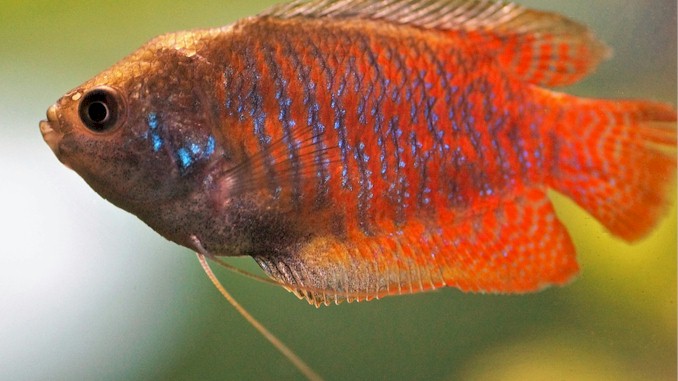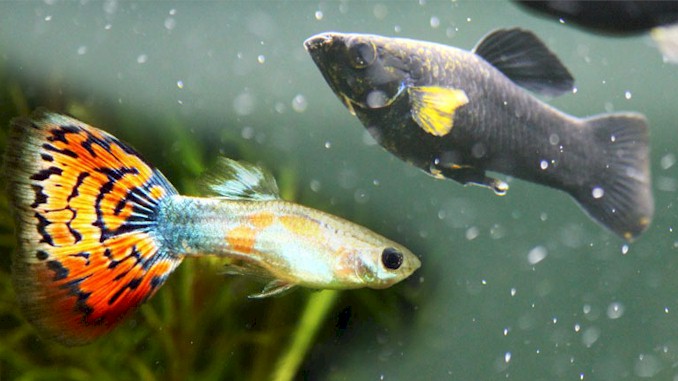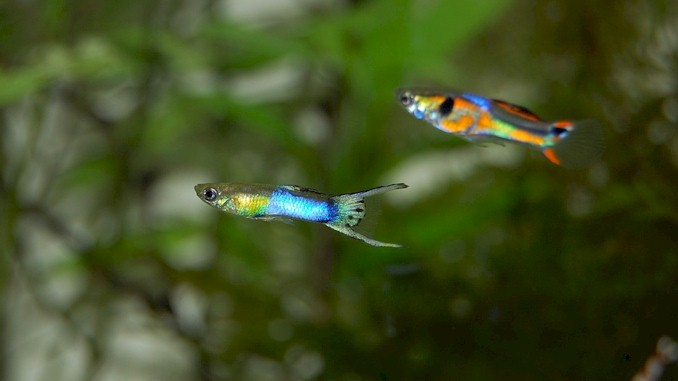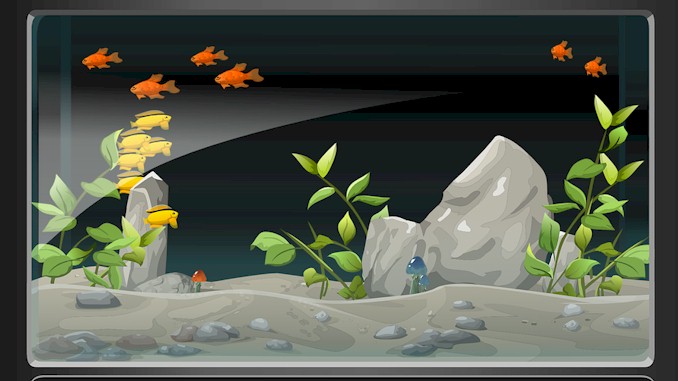Can Guppies and Gouramis Live Together – A Complete Guide
As an avid fish enthusiast, I am constantly on the lookout for colorful and diverse species to add to my aquarium. However, finding suitable tank mates for my beloved guppies can be a daunting task. After some extensive research, I stumbled upon a potential candidate – the Gourami. These tropical fish are not only stunning in appearance but also known for their peaceful demeanor, making them a great addition to a community tank. But the question remains, can they truly coexist harmoniously with guppies?
Guppies and gouramis can live together in the same tank, but caution is advised. Gouramis can be aggressive towards smaller fish, including guppies, especially during mating or feeding times. It is essential to ensure that the tank is spacious enough to provide hiding places and territories for both species, and the water parameters are suitable for their needs.
If you’re considering keeping guppies and gouramis together in an aquarium, it’s important to understand that it’s not as simple as just putting them in their own fish tank. There are several important factors to consider to ensure that they can live together harmoniously. Luckily, with a little knowledge and preparation, it’s definitely possible to successfully keep guppies and gouramis in the same tank. In this guide, I’ll cover everything you need to know to create a beautiful and healthy aquarium with both guppies and gouramis. So, let’s dive in!
How to Choose Compatible Gouramis for Your Guppy Tank
One of the most important factors to consider when keeping guppies and gouramis together is choosing compatible gourami species. Not all gouramis are suitable for a guppy tank, as some may be too aggressive, too large or too sensitive for your guppies.
Gouramis are a diverse group of fish that belong to the family Osphronemidae. They are native to Asia and Africa, where they inhabit various freshwater habitats such as rivers, streams, ponds and swamps. They have a distinctive feature called a labyrinth organ, which allows them to breathe air from the surface.
There are many different types of gourami fish, and many are popular aquarium fish. These popular gourami species include:
- Dwarf Gourami
- Pearl Gourami
- Honey Gourami
- Sparkling Gourami
- Kissing Gourami
- Three Spot Gourami
- Moonlight Gourami
- Chocolate Gourami
Each of these species has its own characteristics, requirements and behavior that you need to be aware of before adding them to your guppy tank. Some of them are more compatible with guppies than others.
In general, you want to avoid gouramis that are too large or too aggressive for your guppies. Large gouramis such as kissing gouramis or three spot gouramis can grow up to 12 inches long, which means they can easily outcompete or even eat your smaller guppies. Aggressive gouramis such as blue gouramis or chocolate gouramis can be territorial or nippy towards your peaceful guppies.
On the other hand, you want to choose gouramis that are small, peaceful and hardy enough for your guppy tank. Small gouramis such as dwarf gouramis or sparkling gouramis can grow up to 3 inches long, which means they can coexist peacefully with your similarly sized guppies. Peaceful gouramis such as pearl gouramis or honey gouramis can get along well with most other community fish. Hardy gouramis such as dwarf labyrinths or licorice labyrinths can adapt well to varying water conditions.
Of course, there are exceptions and variations among individual fish personalities, so you should always observe your fish carefully and provide enough space, hiding places and plants for them to feel comfortable.
In this section, I will go over some of the most popular and compatible types of small peaceful hardy labyrinths for your aquarium: dwarf labyrinths (Colisa lalia), pearl labyrinths (Trichopodus leerii), honey labyrinths (Trichogaster chuna), sparkling labyrinths (Trichopsis pumila) and licorice labyrinths (Parosphromenus deissneri). I will explain their appearance, temperament, care requirements and compatibility with other fish.
- Dwarf Labyrinths (Colisa lalia) are also known as the “dwarf gourami” and are one of the most popular choices for community tanks. They are typically small in size, reaching up to 3 inches in length, and are known for their vibrant colors and interesting patterns. Dwarf Labyrinths are generally peaceful, making them a great choice for community tanks, but they can become aggressive towards their own species or other labyrinth fish.
- Pearl Labyrinths (Trichopodus leerii) are another popular choice for community tanks. They are slightly larger than Dwarf Labyrinths, reaching up to 4 inches in length, and are named for the distinctive pearl-like spots on their bodies. Pearl Labyrinths are generally peaceful and can be kept with a variety of other peaceful fish, including guppies.
- Honey Labyrinths (Trichogaster chuna), also known as “Golden Gouramis,” are another popular choice for community tanks. They are slightly larger than Pearl Labyrinths, reaching up to 5 inches in length, and are known for their bright golden color. Honey Labyrinths are generally peaceful, making them a good choice for community tanks, but they can be territorial towards other labyrinth fish.
- Sparkling Labyrinths (Trichopsis pumila) are a smaller and more delicate species of labyrinth fish. They are typically only 1-2 inches in length and are known for their bright blue color and iridescent scales. Sparkling Labyrinths are generally peaceful and can be kept with other small, peaceful fish such as guppies, but they are not recommended for tanks with larger or more aggressive fish.
- Licorice Labyrinths (Parosphromenus deissneri) are a lesser-known species of labyrinth fish that are native to Southeast Asia. They are a bit more challenging to care for than some of the other species on this list, but their unique appearance and peaceful temperament make them a popular choice for experienced hobbyists. Licorice Labyrinths are typically only 2-3 inches in length and are known for their dark coloration and distinctive fins. They are generally peaceful and can be kept with other small, peaceful fish such as guppies, but they do require a specific set of water conditions to thrive.
In general, when adding any type of labyrinth fish to a community tank with guppies, it’s important to consider their temperament and compatibility with other fish in the tank. It’s also important to ensure that the tank is properly sized and maintained to provide a healthy environment for all of the fish.
Understanding Guppy and Gourami Behavior: Tips for Compatibility in the Same Tank
Understanding the behavior of guppies and gouramis is crucial to ensure that they can coexist in the same tank peacefully. Guppies are known for their peaceful and social behavior, making them great tank mates for various fish species. On the other hand, gouramis can be aggressive towards smaller fish, making it essential to choose the right species and size of gourami to ensure compatibility.
When introducing guppies and gouramis into the same tank, it is vital to observe their behavior closely. Guppies tend to stay near the surface of the water, while gouramis are bottom dwellers. This means that they tend to occupy different areas of the tank, reducing the chances of conflict. However, territorial aggression can still occur, especially if there is not enough space or hiding places in the tank. It is crucial to ensure that the tank is large enough to accommodate both species and that there are enough plants, rocks, or decorations to provide hiding places and territories for both fish.
Another essential factor to consider when keeping guppies and gouramis together is the ratio of males to females. Guppies reproduce rapidly and can become overcrowded quickly, leading to aggression towards other fish. To prevent this, it is best to keep one male guppy for every two to three female guppies. For gouramis, it is best to keep only one male per tank to prevent fighting for dominance.
In summary, understanding the behavior of guppies and gouramis is essential to ensure compatibility in the same tank. By observing their behavior closely, providing enough space and hiding places, and maintaining the proper male-to-female ratio, you can create a harmonious environment for both species. In the next section, we will discuss the factors to consider when keeping guppies and gouramis together in more detail.
Factors to Consider When Keeping Guppies and Gouramis Together
When it comes to keeping guppies and gouramis together, several factors must be considered to ensure the well-being of both species. These factors include water parameters, tank size, filtration, and feeding habits.
Firstly, water parameters are crucial for the health and well-being of both guppies and gouramis. Guppies prefer a slightly alkaline pH between 7.0 and 8.2, while gouramis prefer a pH range of 6.0 to 7.5. It is essential to maintain stable water parameters, including temperature, pH, ammonia, nitrite, and nitrate levels, through regular water changes and proper filtration.
Secondly, the tank size is an important factor to consider when keeping guppies and gouramis together. As previously mentioned, gouramis can be aggressive towards smaller fish, including guppies. Therefore, it is essential to provide enough space for both species to coexist peacefully. A general rule of thumb is to have at least 10 gallons of water for every inch of adult fish. For example, if you have three guppies and one gourami, you would need a minimum of a 20-gallon tank.
Thirdly, filtration is essential for maintaining a healthy and stable aquarium environment. Guppies and gouramis produce waste, which can accumulate in the tank and harm the fish. It is important to choose a filter that is appropriate for the tank size and provides sufficient mechanical, biological, and chemical filtration. Regular cleaning and maintenance of the filter are also necessary to ensure optimal performance.
Fourthly, feeding habits are an important consideration when keeping guppies and gouramis together. Both species have different feeding habits, with guppies being omnivores and gouramis being primarily carnivorous. It is important to provide a balanced diet for both species, including high-quality flakes, pellets, and frozen or live foods. Overfeeding can lead to excess waste and poor water quality, so it is essential to feed only what the fish can consume in a few minutes.
In summary, several factors must be considered when keeping guppies and gouramis together, including water parameters, tank size, filtration, and feeding habits. By maintaining stable water parameters, providing enough space, choosing the right filter, and feeding a balanced diet, you can create a healthy and harmonious environment for both species. In the next section, we will discuss how to identify and resolve potential problems when keeping guppies and gouramis together.
How to Prevent or Deal with Common Problems in a Guppy-Gourami Tank
Keeping guppies and gouramis together can be rewarding but also challenging. These fish may encounter some common problems that can affect their health and well-being. Some of these problems are:
- Aggression: Gouramis can be territorial and aggressive towards other fish especially if they feel threatened or crowded. They may chase nip or even kill guppies that are smaller and weaker than them. To prevent this you need to provide enough space for each fish at least 2 gallons per gourami. You also need to add plenty of plants rocks driftwood or other decorations that can create hiding places for guppies. You can also choose peaceful varieties of gouramis such as dwarf honey or pearl gouramis that are less likely to harm guppies.
- Poor water quality: Both guppies and gouramis are sensitive to water quality changes that can cause stress disease or death. You need to monitor your water parameters regularly such as pH ammonia nitrite nitrate temperature hardness etc. You also need to perform regular water changes at least 25% every week. You should use a filter that can handle the bioload of your tank and remove any uneaten food waste or debris. You should also avoid overstocking your tank as this can lead to overcrowding pollution and oxygen depletion.
- Disease: Both guppies and gouramis are prone to various diseases such as fin rot ich velvet fungus bacterial infections parasites etc. These diseases can spread quickly among your fish if not treated promptly. To prevent disease you need to keep your water quality high quarantine new fish before adding them to your tank observe your fish daily for any signs of illness avoid cross-contamination between tanks etc. To treat disease you need to identify the cause of the problem isolate sick fish from healthy ones use appropriate medications follow instructions carefully etc.
- Swim bladder disorder: This is a condition where a fish loses its ability to swim upright due to a malfunctioning swim bladder. The swim bladder is an organ that helps a fish control its buoyancy by inflating or deflating with air. A fish with swim bladder disorder may swim on its side upside down or float at the surface or sink at the bottom. The causes of swim bladder disorder can be overfeeding constipation infection injury stress etc. To prevent swim bladder disorder you need to feed your fish small portions twice a day avoid overfeeding them offer them some vegetable matter such as peas lettuce spinach etc. reduce stress factors such as loud noises bright lights sudden movements etc. To treat swim bladder disorder you need to check your water quality perform a water change eliminate any stressors treat any underlying illnesses check if your fish is asleep etc.
Here is a list of some common signs of problems in a guppy-gourami tank:
- Faded colors
- Clamped fins
- Lethargy
- Loss of appetite
- Scratching against objects
- Gasping at the surface
- Swollen abdomen
- White spots on body
- Red streaks on fins
If you notice any of these signs in your fish you need to act quickly and find out what is wrong. The sooner you diagnose and treat the problem the better chances your fish have of recovering.
Keeping guppies and gouramis together can be fun but it also requires some care and attention. By following these tips you can prevent or deal with common problems in a guppy-gourami tank. Remember that prevention is always better than cure!
How to Feed Your Guppies and Gouramis Properly
One of the key aspects of keeping guppies and gouramis healthy and happy is providing them with a proper diet. Both fish are omnivorous, meaning they eat both plant-based and animal matter. However, they have different preferences and nutritional needs that you need to consider.
Guppies are not picky eaters, and tend to eat just about anything. In their natural habitat, they feed on mosquito larvae and other live foods. In captivity, they can thrive on a variety of foods such as flakes, pellets, freeze-dried or frozen foods. However, they also need some vegetable matter in their diet to prevent constipation and bloating. You can offer them cooked peas, lettuce, spinach or cucumber as occasional treats2.
Gouramis are also omnivorous but they lean more towards meaty foods than guppies. In their natural habitat, they feed on insects, crustaceans and worms. In captivity, they can also accept flakes or pellets as staple foods but they need more live or frozen foods such as brine shrimp, daphnia or bloodworms to bring out their colors and stimulate their natural behavior. They also enjoy some vegetable matter in their diet such as algae wafers or blanched zucchini.
To feed your guppies and gouramis properly you need to follow some basic guidelines:
- Feed them twice a day with small portions that they can finish within 2-3 minutes
- Vary their diet with different types of foods such as flakes/pellets/live/frozen/vegetable
- Avoid overfeeding them as this can cause water quality issues and health problems
- Remove any uneaten food after each feeding session
- Supplement their diet with vitamins or minerals if needed
Here is a table that summarizes the dietary preferences of guppies and gouramis:
| Fish | Flakes/Pellets | Live/Frozen Foods | Vegetable Matter |
|---|---|---|---|
| Guppy | Yes (staple) | Yes (occasional) | Yes (occasional) |
| Gourami | Yes (staple) | Yes (regular) | Yes (regular) |
As you can see from this table both fish require similar types of foods but in different proportions. You can feed them together from the same source but make sure that each fish gets enough of what it needs.
Feeding your guppies and gouramis properly will ensure that they grow well stay healthy display vibrant colors breed successfully interact peacefully with each other. Remember that a well-fed fish is a happy fish!
How to Create a Beautiful and Harmonious Aquarium with Guppies and Gouramis
Creating a beautiful and harmonious aquarium with guppies and gouramis is not only beneficial for the fish but also visually pleasing for the viewer. Here are some tips to help you achieve this:
- Choosing the right tank size: The tank size should be suitable for the number of fish you plan to keep. A 20-gallon tank is suitable for a small community of guppies and gouramis.
- Adding appropriate decor: Adding plants, rocks, and other decor can provide hiding spots for the fish and create a more natural environment. Live plants can also improve water quality by absorbing excess nutrients and producing oxygen.
- Providing proper lighting: Adequate lighting is necessary for plant growth and to promote the natural behavior of the fish. A timer can be used to simulate a natural day-night cycle.
- Maintaining proper water parameters: As previously discussed, maintaining stable water parameters is essential for the health of the fish. Regular water changes and proper filtration can help maintain optimal water quality.
- Choosing suitable tank mates: It is important to choose tank mates that are compatible with guppies and gouramis. Peaceful fish such as tetras, corydoras, and platies are good choices.
- Feeding the fish appropriately: Providing a varied diet and avoiding overfeeding is crucial for the health of the fish. Guppies and gouramis are omnivores and can be fed a combination of flakes, pellets, and live or frozen foods.
By following these tips, you can create a beautiful and harmonious aquarium with guppies and gouramis. In the next section, we will discuss the benefits and drawbacks of keeping guppies and gouramis together.
Best Practices for Maintaining the Health and Well-being of Guppies and Gouramis in the Same Tank
Maintaining the health and well-being of guppies and gouramis in the same tank requires attention to several key factors. Here are some best practices to help keep your fish healthy:
- Monitor water parameters: Regularly test the water for pH, ammonia, nitrite, and nitrate levels to ensure that they are within acceptable ranges. Maintain a consistent temperature between 75-82°F.
- Provide proper filtration: A good filter system is essential for maintaining water quality. Make sure the filter is appropriate for the size of your tank and is properly maintained.
- Avoid overstocking: Overcrowding can lead to increased stress and aggression among fish, which can lead to health problems. A general rule is to have no more than 1 inch of fish per gallon of water.
- Feed a balanced diet: Guppies and gouramis are omnivores and require a balanced diet consisting of both plant and animal-based foods. Avoid overfeeding, as excess food can lead to poor water quality.
- Quarantine new fish: Before introducing new fish to your tank, quarantine them for at least two weeks to prevent the spread of diseases.
- Monitor fish behavior: Keep an eye on the behavior of your fish. Signs of stress or illness include lethargy, loss of appetite, and abnormal swimming patterns. If you notice any of these signs, take action immediately.
By following these best practices, you can help ensure the health and well-being of your guppies and gouramis in the same tank. In conclusion, guppies and gouramis can live together, but it requires careful consideration and attention to their individual needs. With the right setup and care, these two species can coexist peacefully and create a beautiful and thriving aquarium.







